Leadership Self-Assessment Essay: Strengths, Styles, and Justification
VerifiedAdded on 2022/09/07
|9
|1707
|20
Essay
AI Summary
This essay analyzes the author's leadership strengths, identified through a self-assessment tool, focusing on confidence, critical thinking, and emotional intelligence. The author identifies transformational leadership as a preferred style, aligning with their strengths, particularly in critical thinking and emotional intelligence. The essay explores how these strengths can be applied in a managerial role. The impact of these strengths on the transformational leadership style is discussed, emphasizing the ability to foster innovation and manage change. The justification for the chosen leadership style is provided using the trait and behavioral leadership theories. The author concludes that transformational leadership is the most suitable approach, aligning with their behavior and strengths.
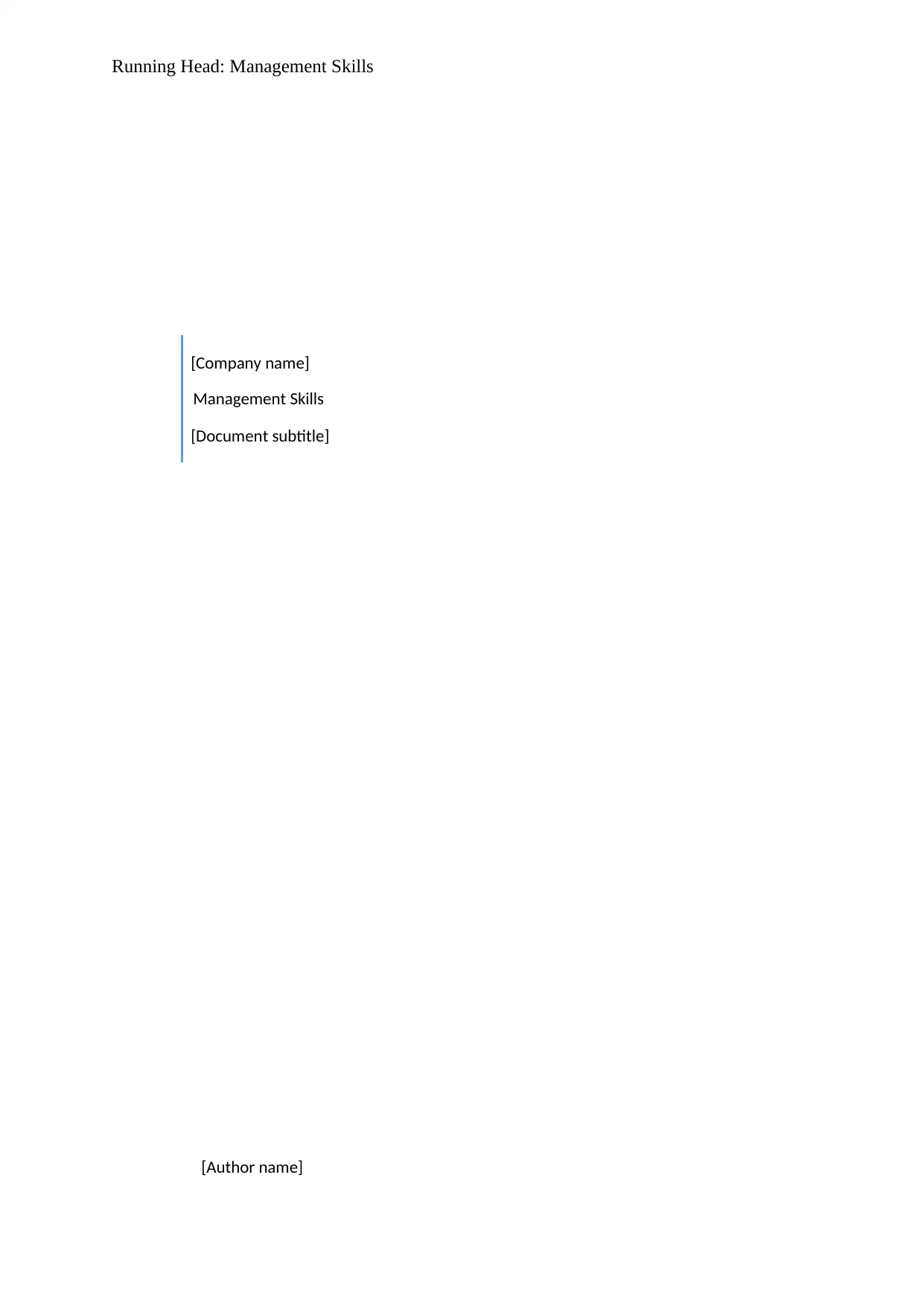
Running Head: Management Skills
[Company name]
Management Skills
[Document subtitle]
[Author name]
[Company name]
Management Skills
[Document subtitle]
[Author name]
Paraphrase This Document
Need a fresh take? Get an instant paraphrase of this document with our AI Paraphraser
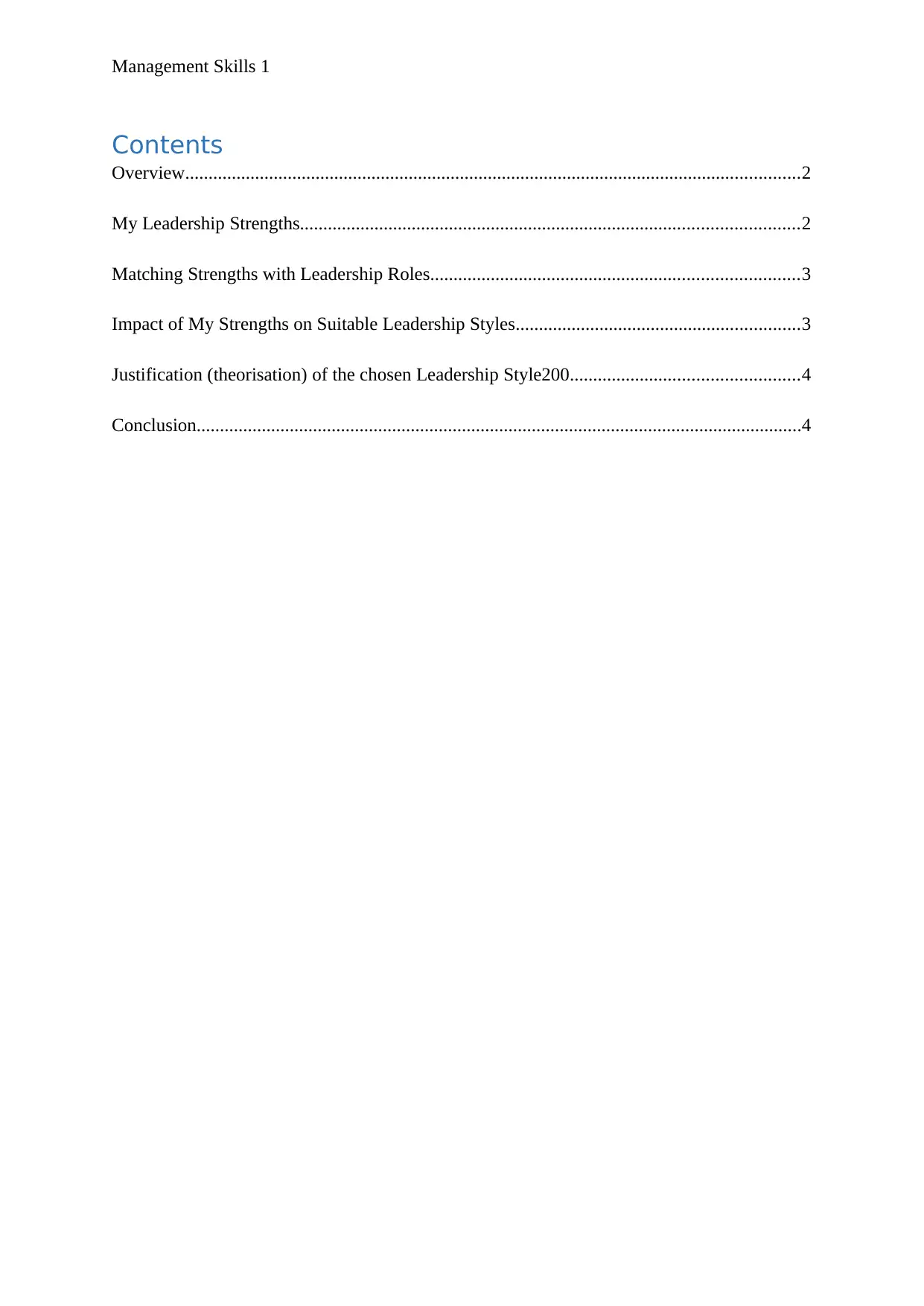
Management Skills 1
Contents
Overview....................................................................................................................................2
My Leadership Strengths...........................................................................................................2
Matching Strengths with Leadership Roles...............................................................................3
Impact of My Strengths on Suitable Leadership Styles.............................................................3
Justification (theorisation) of the chosen Leadership Style200.................................................4
Conclusion..................................................................................................................................4
Contents
Overview....................................................................................................................................2
My Leadership Strengths...........................................................................................................2
Matching Strengths with Leadership Roles...............................................................................3
Impact of My Strengths on Suitable Leadership Styles.............................................................3
Justification (theorisation) of the chosen Leadership Style200.................................................4
Conclusion..................................................................................................................................4
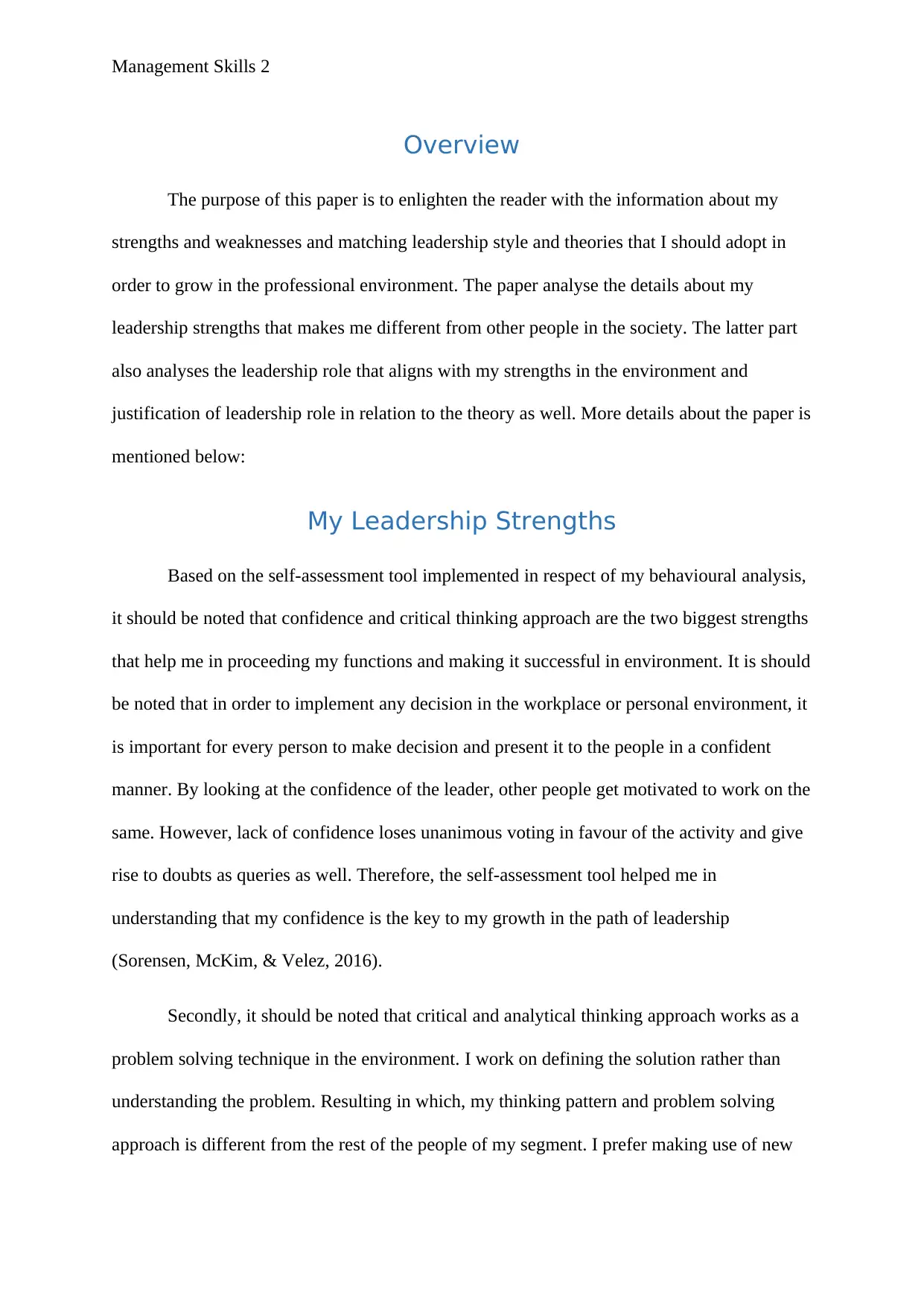
Management Skills 2
Overview
The purpose of this paper is to enlighten the reader with the information about my
strengths and weaknesses and matching leadership style and theories that I should adopt in
order to grow in the professional environment. The paper analyse the details about my
leadership strengths that makes me different from other people in the society. The latter part
also analyses the leadership role that aligns with my strengths in the environment and
justification of leadership role in relation to the theory as well. More details about the paper is
mentioned below:
My Leadership Strengths
Based on the self-assessment tool implemented in respect of my behavioural analysis,
it should be noted that confidence and critical thinking approach are the two biggest strengths
that help me in proceeding my functions and making it successful in environment. It is should
be noted that in order to implement any decision in the workplace or personal environment, it
is important for every person to make decision and present it to the people in a confident
manner. By looking at the confidence of the leader, other people get motivated to work on the
same. However, lack of confidence loses unanimous voting in favour of the activity and give
rise to doubts as queries as well. Therefore, the self-assessment tool helped me in
understanding that my confidence is the key to my growth in the path of leadership
(Sorensen, McKim, & Velez, 2016).
Secondly, it should be noted that critical and analytical thinking approach works as a
problem solving technique in the environment. I work on defining the solution rather than
understanding the problem. Resulting in which, my thinking pattern and problem solving
approach is different from the rest of the people of my segment. I prefer making use of new
Overview
The purpose of this paper is to enlighten the reader with the information about my
strengths and weaknesses and matching leadership style and theories that I should adopt in
order to grow in the professional environment. The paper analyse the details about my
leadership strengths that makes me different from other people in the society. The latter part
also analyses the leadership role that aligns with my strengths in the environment and
justification of leadership role in relation to the theory as well. More details about the paper is
mentioned below:
My Leadership Strengths
Based on the self-assessment tool implemented in respect of my behavioural analysis,
it should be noted that confidence and critical thinking approach are the two biggest strengths
that help me in proceeding my functions and making it successful in environment. It is should
be noted that in order to implement any decision in the workplace or personal environment, it
is important for every person to make decision and present it to the people in a confident
manner. By looking at the confidence of the leader, other people get motivated to work on the
same. However, lack of confidence loses unanimous voting in favour of the activity and give
rise to doubts as queries as well. Therefore, the self-assessment tool helped me in
understanding that my confidence is the key to my growth in the path of leadership
(Sorensen, McKim, & Velez, 2016).
Secondly, it should be noted that critical and analytical thinking approach works as a
problem solving technique in the environment. I work on defining the solution rather than
understanding the problem. Resulting in which, my thinking pattern and problem solving
approach is different from the rest of the people of my segment. I prefer making use of new
⊘ This is a preview!⊘
Do you want full access?
Subscribe today to unlock all pages.

Trusted by 1+ million students worldwide
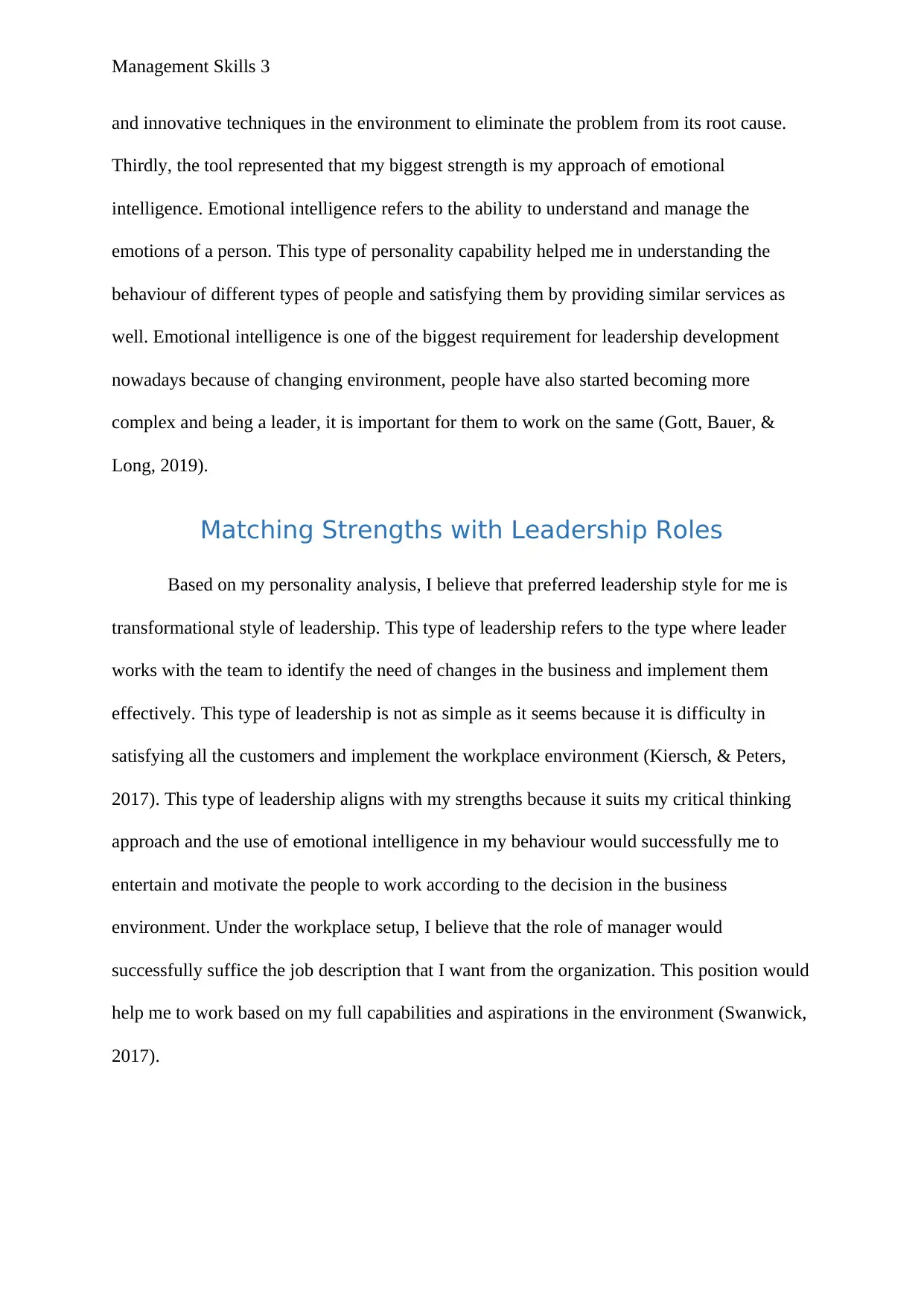
Management Skills 3
and innovative techniques in the environment to eliminate the problem from its root cause.
Thirdly, the tool represented that my biggest strength is my approach of emotional
intelligence. Emotional intelligence refers to the ability to understand and manage the
emotions of a person. This type of personality capability helped me in understanding the
behaviour of different types of people and satisfying them by providing similar services as
well. Emotional intelligence is one of the biggest requirement for leadership development
nowadays because of changing environment, people have also started becoming more
complex and being a leader, it is important for them to work on the same (Gott, Bauer, &
Long, 2019).
Matching Strengths with Leadership Roles
Based on my personality analysis, I believe that preferred leadership style for me is
transformational style of leadership. This type of leadership refers to the type where leader
works with the team to identify the need of changes in the business and implement them
effectively. This type of leadership is not as simple as it seems because it is difficulty in
satisfying all the customers and implement the workplace environment (Kiersch, & Peters,
2017). This type of leadership aligns with my strengths because it suits my critical thinking
approach and the use of emotional intelligence in my behaviour would successfully me to
entertain and motivate the people to work according to the decision in the business
environment. Under the workplace setup, I believe that the role of manager would
successfully suffice the job description that I want from the organization. This position would
help me to work based on my full capabilities and aspirations in the environment (Swanwick,
2017).
and innovative techniques in the environment to eliminate the problem from its root cause.
Thirdly, the tool represented that my biggest strength is my approach of emotional
intelligence. Emotional intelligence refers to the ability to understand and manage the
emotions of a person. This type of personality capability helped me in understanding the
behaviour of different types of people and satisfying them by providing similar services as
well. Emotional intelligence is one of the biggest requirement for leadership development
nowadays because of changing environment, people have also started becoming more
complex and being a leader, it is important for them to work on the same (Gott, Bauer, &
Long, 2019).
Matching Strengths with Leadership Roles
Based on my personality analysis, I believe that preferred leadership style for me is
transformational style of leadership. This type of leadership refers to the type where leader
works with the team to identify the need of changes in the business and implement them
effectively. This type of leadership is not as simple as it seems because it is difficulty in
satisfying all the customers and implement the workplace environment (Kiersch, & Peters,
2017). This type of leadership aligns with my strengths because it suits my critical thinking
approach and the use of emotional intelligence in my behaviour would successfully me to
entertain and motivate the people to work according to the decision in the business
environment. Under the workplace setup, I believe that the role of manager would
successfully suffice the job description that I want from the organization. This position would
help me to work based on my full capabilities and aspirations in the environment (Swanwick,
2017).
Paraphrase This Document
Need a fresh take? Get an instant paraphrase of this document with our AI Paraphraser
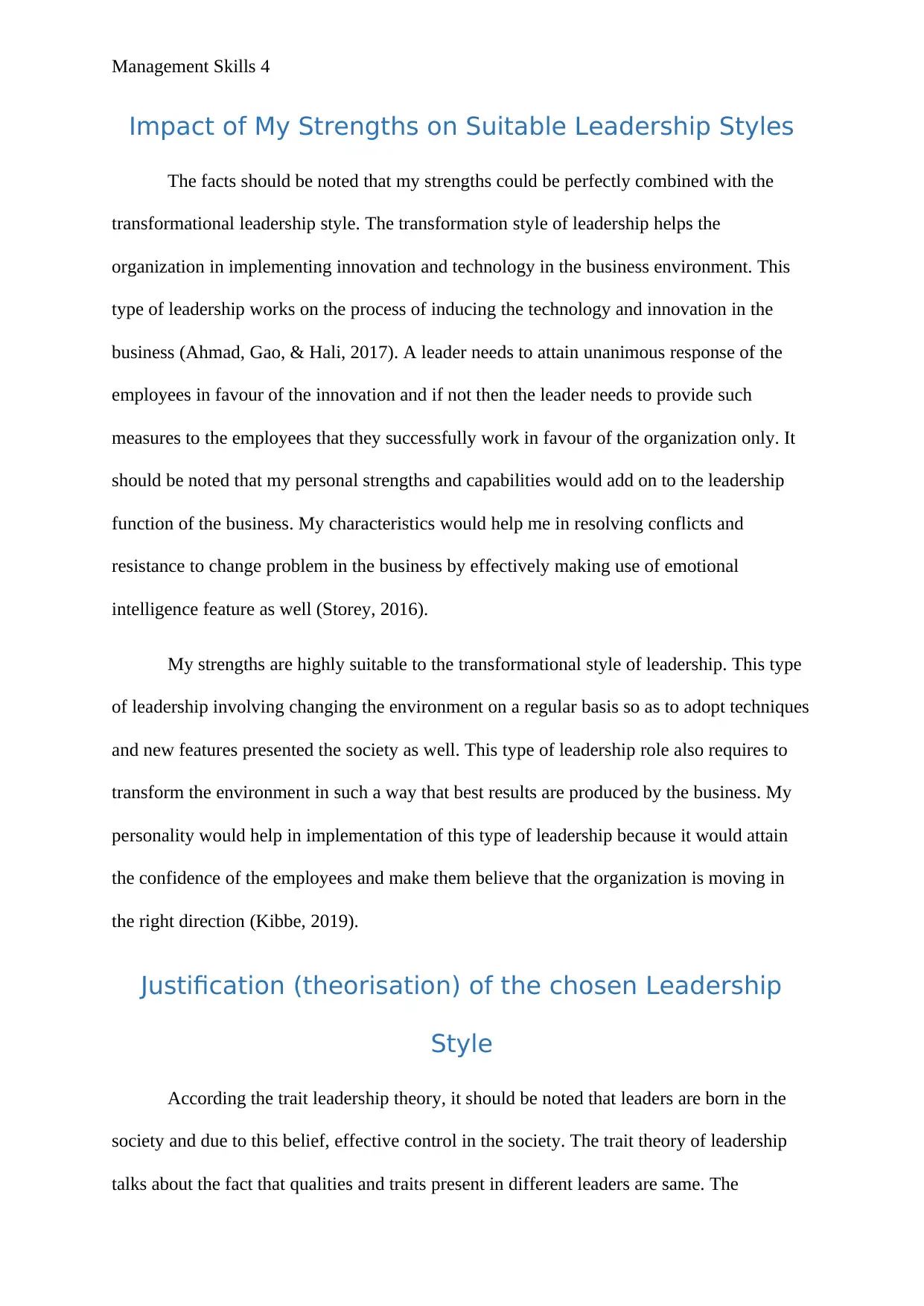
Management Skills 4
Impact of My Strengths on Suitable Leadership Styles
The facts should be noted that my strengths could be perfectly combined with the
transformational leadership style. The transformation style of leadership helps the
organization in implementing innovation and technology in the business environment. This
type of leadership works on the process of inducing the technology and innovation in the
business (Ahmad, Gao, & Hali, 2017). A leader needs to attain unanimous response of the
employees in favour of the innovation and if not then the leader needs to provide such
measures to the employees that they successfully work in favour of the organization only. It
should be noted that my personal strengths and capabilities would add on to the leadership
function of the business. My characteristics would help me in resolving conflicts and
resistance to change problem in the business by effectively making use of emotional
intelligence feature as well (Storey, 2016).
My strengths are highly suitable to the transformational style of leadership. This type
of leadership involving changing the environment on a regular basis so as to adopt techniques
and new features presented the society as well. This type of leadership role also requires to
transform the environment in such a way that best results are produced by the business. My
personality would help in implementation of this type of leadership because it would attain
the confidence of the employees and make them believe that the organization is moving in
the right direction (Kibbe, 2019).
Justification (theorisation) of the chosen Leadership
Style
According the trait leadership theory, it should be noted that leaders are born in the
society and due to this belief, effective control in the society. The trait theory of leadership
talks about the fact that qualities and traits present in different leaders are same. The
Impact of My Strengths on Suitable Leadership Styles
The facts should be noted that my strengths could be perfectly combined with the
transformational leadership style. The transformation style of leadership helps the
organization in implementing innovation and technology in the business environment. This
type of leadership works on the process of inducing the technology and innovation in the
business (Ahmad, Gao, & Hali, 2017). A leader needs to attain unanimous response of the
employees in favour of the innovation and if not then the leader needs to provide such
measures to the employees that they successfully work in favour of the organization only. It
should be noted that my personal strengths and capabilities would add on to the leadership
function of the business. My characteristics would help me in resolving conflicts and
resistance to change problem in the business by effectively making use of emotional
intelligence feature as well (Storey, 2016).
My strengths are highly suitable to the transformational style of leadership. This type
of leadership involving changing the environment on a regular basis so as to adopt techniques
and new features presented the society as well. This type of leadership role also requires to
transform the environment in such a way that best results are produced by the business. My
personality would help in implementation of this type of leadership because it would attain
the confidence of the employees and make them believe that the organization is moving in
the right direction (Kibbe, 2019).
Justification (theorisation) of the chosen Leadership
Style
According the trait leadership theory, it should be noted that leaders are born in the
society and due to this belief, effective control in the society. The trait theory of leadership
talks about the fact that qualities and traits present in different leaders are same. The
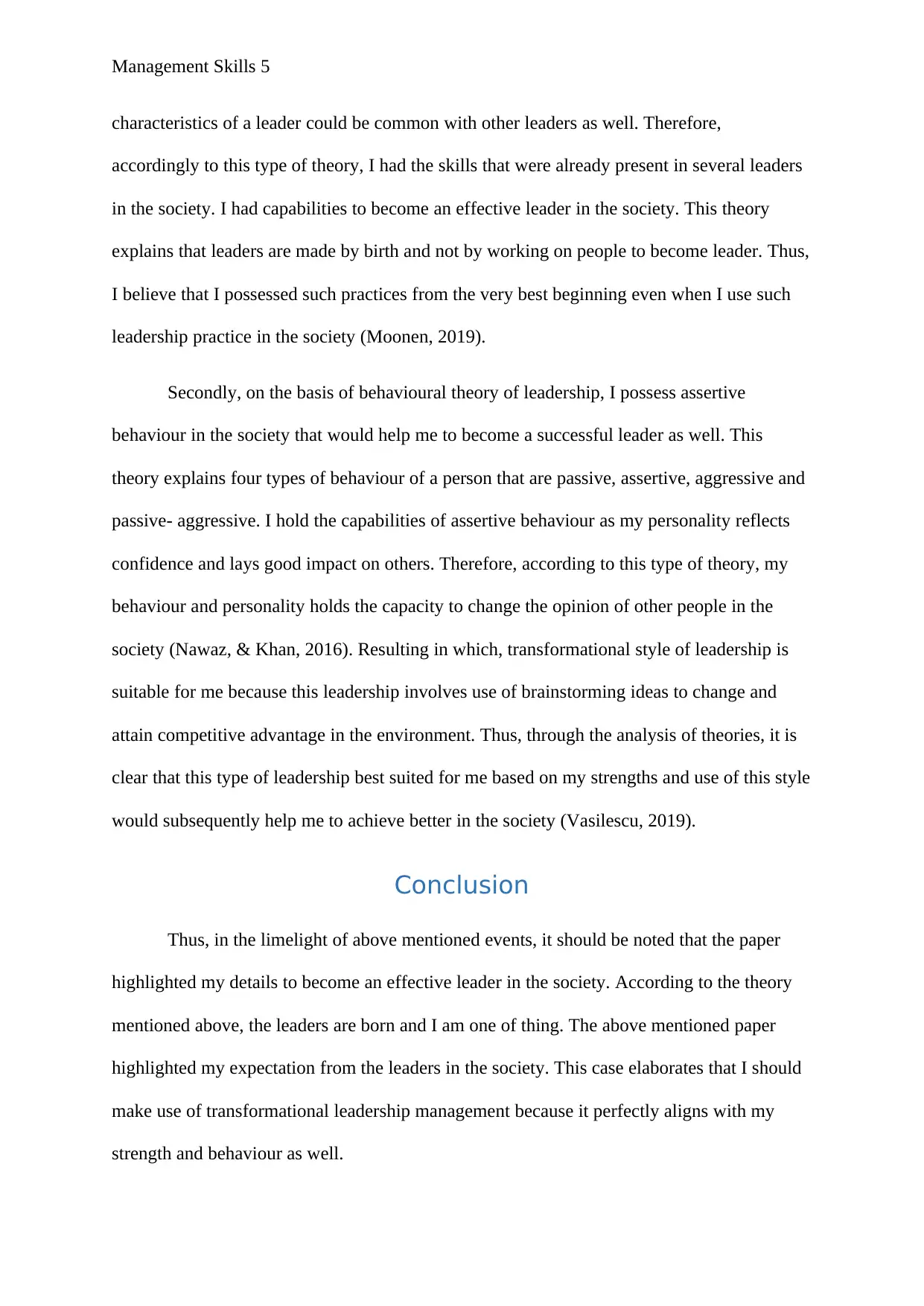
Management Skills 5
characteristics of a leader could be common with other leaders as well. Therefore,
accordingly to this type of theory, I had the skills that were already present in several leaders
in the society. I had capabilities to become an effective leader in the society. This theory
explains that leaders are made by birth and not by working on people to become leader. Thus,
I believe that I possessed such practices from the very best beginning even when I use such
leadership practice in the society (Moonen, 2019).
Secondly, on the basis of behavioural theory of leadership, I possess assertive
behaviour in the society that would help me to become a successful leader as well. This
theory explains four types of behaviour of a person that are passive, assertive, aggressive and
passive- aggressive. I hold the capabilities of assertive behaviour as my personality reflects
confidence and lays good impact on others. Therefore, according to this type of theory, my
behaviour and personality holds the capacity to change the opinion of other people in the
society (Nawaz, & Khan, 2016). Resulting in which, transformational style of leadership is
suitable for me because this leadership involves use of brainstorming ideas to change and
attain competitive advantage in the environment. Thus, through the analysis of theories, it is
clear that this type of leadership best suited for me based on my strengths and use of this style
would subsequently help me to achieve better in the society (Vasilescu, 2019).
Conclusion
Thus, in the limelight of above mentioned events, it should be noted that the paper
highlighted my details to become an effective leader in the society. According to the theory
mentioned above, the leaders are born and I am one of thing. The above mentioned paper
highlighted my expectation from the leaders in the society. This case elaborates that I should
make use of transformational leadership management because it perfectly aligns with my
strength and behaviour as well.
characteristics of a leader could be common with other leaders as well. Therefore,
accordingly to this type of theory, I had the skills that were already present in several leaders
in the society. I had capabilities to become an effective leader in the society. This theory
explains that leaders are made by birth and not by working on people to become leader. Thus,
I believe that I possessed such practices from the very best beginning even when I use such
leadership practice in the society (Moonen, 2019).
Secondly, on the basis of behavioural theory of leadership, I possess assertive
behaviour in the society that would help me to become a successful leader as well. This
theory explains four types of behaviour of a person that are passive, assertive, aggressive and
passive- aggressive. I hold the capabilities of assertive behaviour as my personality reflects
confidence and lays good impact on others. Therefore, according to this type of theory, my
behaviour and personality holds the capacity to change the opinion of other people in the
society (Nawaz, & Khan, 2016). Resulting in which, transformational style of leadership is
suitable for me because this leadership involves use of brainstorming ideas to change and
attain competitive advantage in the environment. Thus, through the analysis of theories, it is
clear that this type of leadership best suited for me based on my strengths and use of this style
would subsequently help me to achieve better in the society (Vasilescu, 2019).
Conclusion
Thus, in the limelight of above mentioned events, it should be noted that the paper
highlighted my details to become an effective leader in the society. According to the theory
mentioned above, the leaders are born and I am one of thing. The above mentioned paper
highlighted my expectation from the leaders in the society. This case elaborates that I should
make use of transformational leadership management because it perfectly aligns with my
strength and behaviour as well.
⊘ This is a preview!⊘
Do you want full access?
Subscribe today to unlock all pages.

Trusted by 1+ million students worldwide
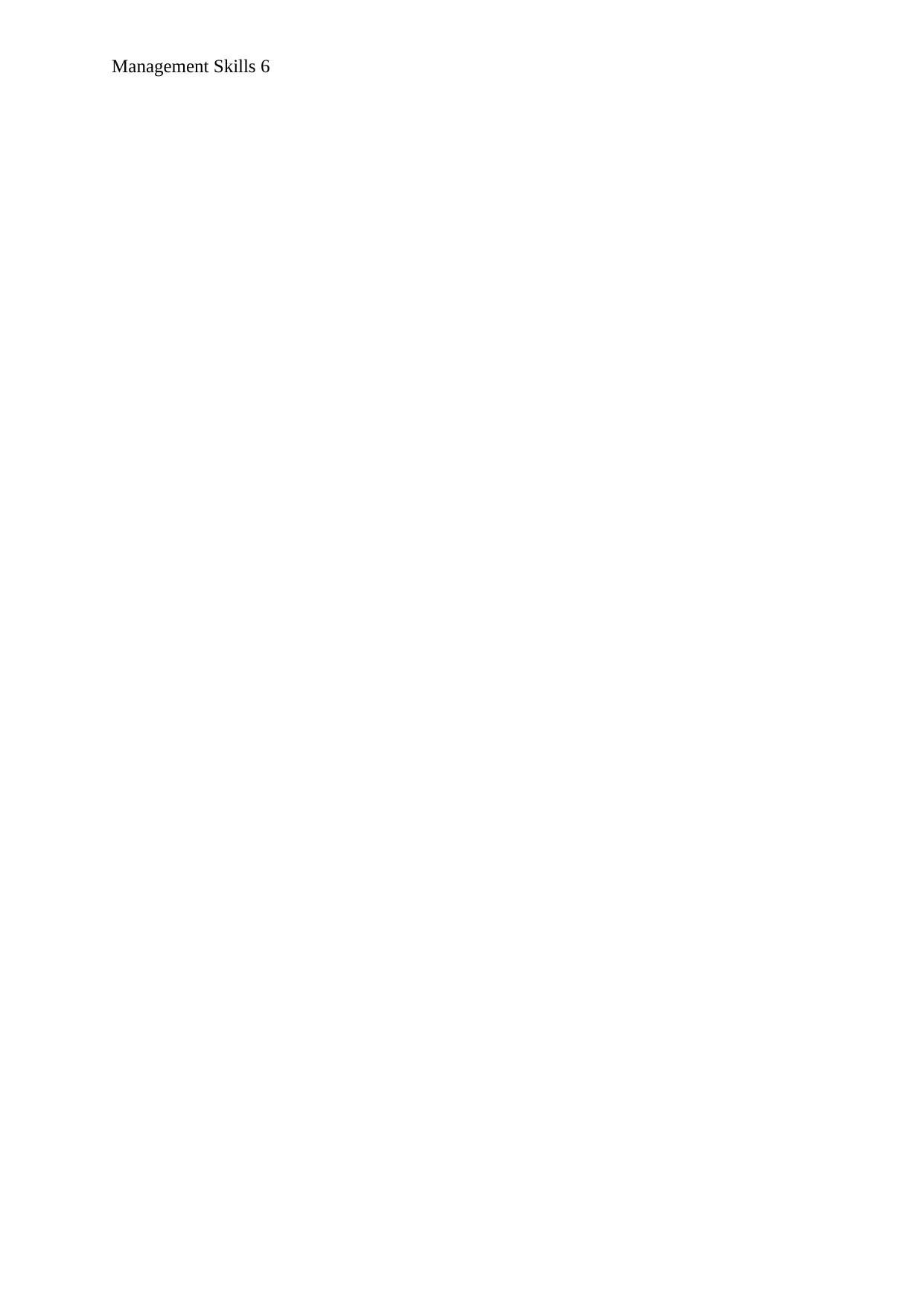
Management Skills 6
Paraphrase This Document
Need a fresh take? Get an instant paraphrase of this document with our AI Paraphraser
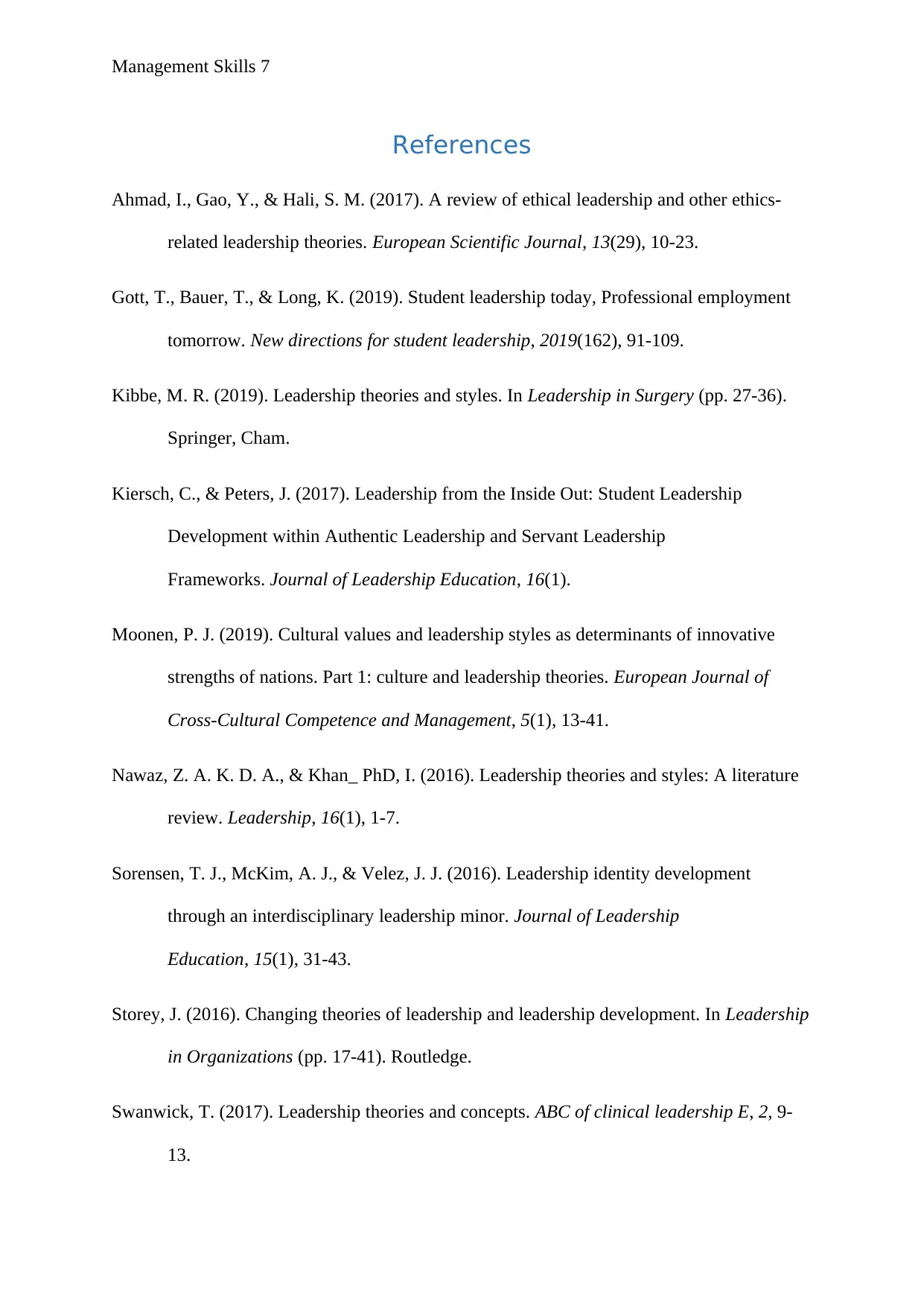
Management Skills 7
References
Ahmad, I., Gao, Y., & Hali, S. M. (2017). A review of ethical leadership and other ethics-
related leadership theories. European Scientific Journal, 13(29), 10-23.
Gott, T., Bauer, T., & Long, K. (2019). Student leadership today, Professional employment
tomorrow. New directions for student leadership, 2019(162), 91-109.
Kibbe, M. R. (2019). Leadership theories and styles. In Leadership in Surgery (pp. 27-36).
Springer, Cham.
Kiersch, C., & Peters, J. (2017). Leadership from the Inside Out: Student Leadership
Development within Authentic Leadership and Servant Leadership
Frameworks. Journal of Leadership Education, 16(1).
Moonen, P. J. (2019). Cultural values and leadership styles as determinants of innovative
strengths of nations. Part 1: culture and leadership theories. European Journal of
Cross-Cultural Competence and Management, 5(1), 13-41.
Nawaz, Z. A. K. D. A., & Khan_ PhD, I. (2016). Leadership theories and styles: A literature
review. Leadership, 16(1), 1-7.
Sorensen, T. J., McKim, A. J., & Velez, J. J. (2016). Leadership identity development
through an interdisciplinary leadership minor. Journal of Leadership
Education, 15(1), 31-43.
Storey, J. (2016). Changing theories of leadership and leadership development. In Leadership
in Organizations (pp. 17-41). Routledge.
Swanwick, T. (2017). Leadership theories and concepts. ABC of clinical leadership E, 2, 9-
13.
References
Ahmad, I., Gao, Y., & Hali, S. M. (2017). A review of ethical leadership and other ethics-
related leadership theories. European Scientific Journal, 13(29), 10-23.
Gott, T., Bauer, T., & Long, K. (2019). Student leadership today, Professional employment
tomorrow. New directions for student leadership, 2019(162), 91-109.
Kibbe, M. R. (2019). Leadership theories and styles. In Leadership in Surgery (pp. 27-36).
Springer, Cham.
Kiersch, C., & Peters, J. (2017). Leadership from the Inside Out: Student Leadership
Development within Authentic Leadership and Servant Leadership
Frameworks. Journal of Leadership Education, 16(1).
Moonen, P. J. (2019). Cultural values and leadership styles as determinants of innovative
strengths of nations. Part 1: culture and leadership theories. European Journal of
Cross-Cultural Competence and Management, 5(1), 13-41.
Nawaz, Z. A. K. D. A., & Khan_ PhD, I. (2016). Leadership theories and styles: A literature
review. Leadership, 16(1), 1-7.
Sorensen, T. J., McKim, A. J., & Velez, J. J. (2016). Leadership identity development
through an interdisciplinary leadership minor. Journal of Leadership
Education, 15(1), 31-43.
Storey, J. (2016). Changing theories of leadership and leadership development. In Leadership
in Organizations (pp. 17-41). Routledge.
Swanwick, T. (2017). Leadership theories and concepts. ABC of clinical leadership E, 2, 9-
13.
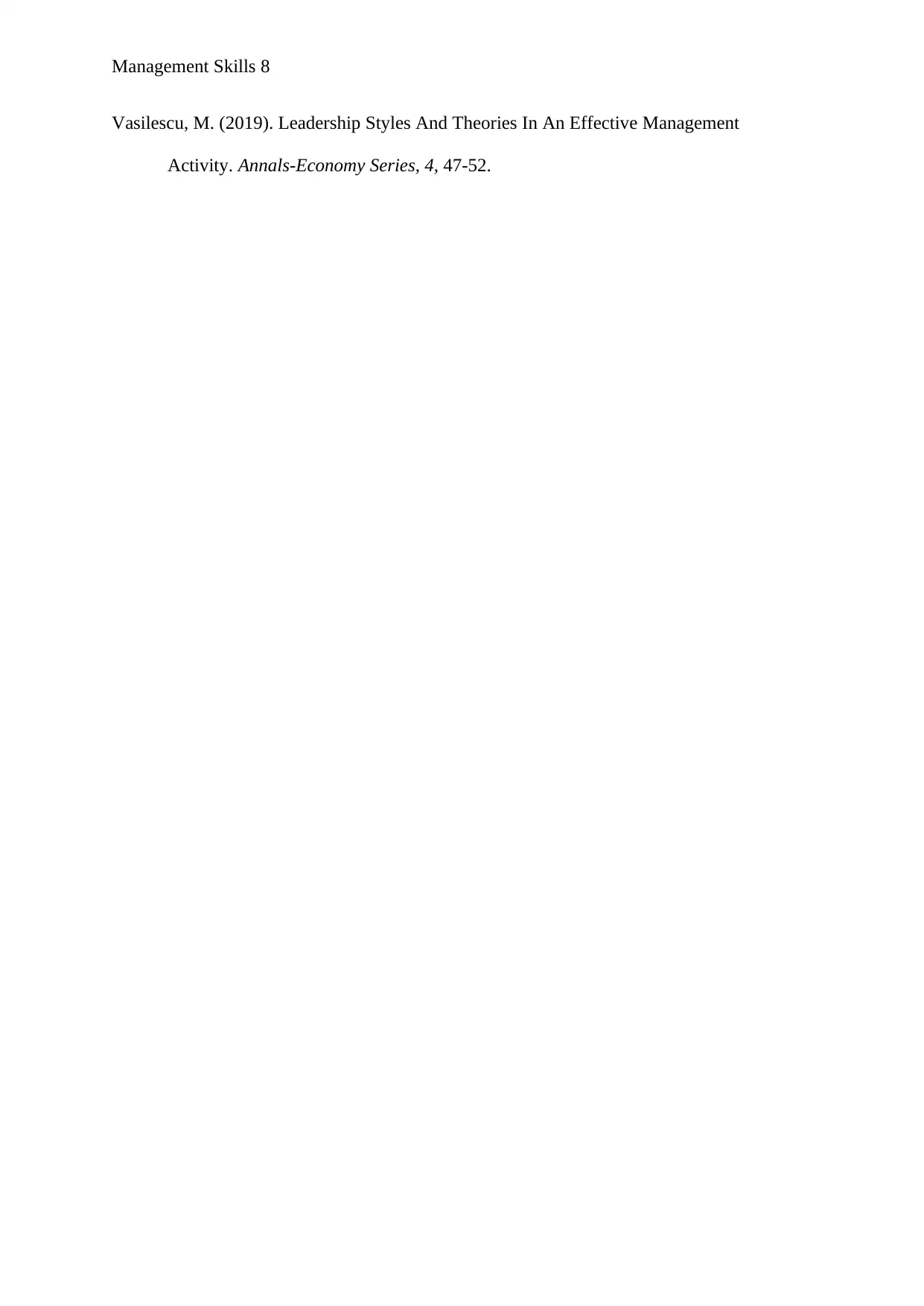
Management Skills 8
Vasilescu, M. (2019). Leadership Styles And Theories In An Effective Management
Activity. Annals-Economy Series, 4, 47-52.
Vasilescu, M. (2019). Leadership Styles And Theories In An Effective Management
Activity. Annals-Economy Series, 4, 47-52.
⊘ This is a preview!⊘
Do you want full access?
Subscribe today to unlock all pages.

Trusted by 1+ million students worldwide
1 out of 9
Related Documents
Your All-in-One AI-Powered Toolkit for Academic Success.
+13062052269
info@desklib.com
Available 24*7 on WhatsApp / Email
![[object Object]](/_next/static/media/star-bottom.7253800d.svg)
Unlock your academic potential
Copyright © 2020–2025 A2Z Services. All Rights Reserved. Developed and managed by ZUCOL.





